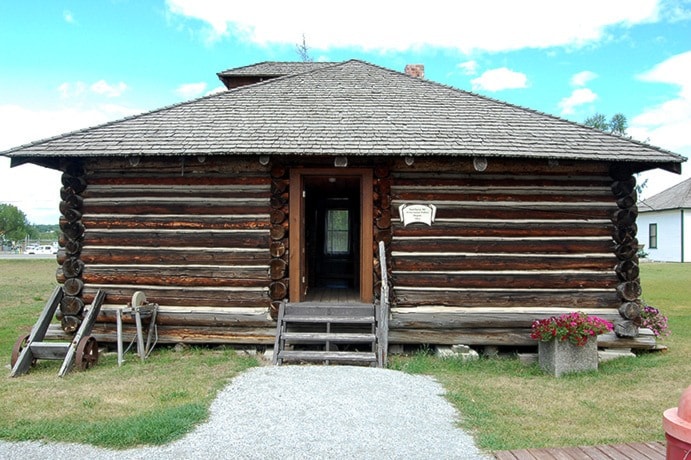The following story was written for the Caledonia Courier newspaper in Fort St. James; I hope Golden Country readers find it of interest.
The first police force in British Columbia was established in the mid-eighteenth century, when the discovery of gold in the province’s Interior necessitated the formation of a body to maintain law and order over the thousands of people arriving in the area to seek their fortune. Over the next few decades the B.C. Provincial Police force grew, expanding its reach town by town as demand for its services increased.
The Last Spike in the Grand Trunk Pacific Railway was pounded near Fort Fraser on April 7, 1914, drawing an influx of new settlers. In the summer of 1914 the B.C. Provincial Police established a detachment in nearby Vanderhoof; a log building situated at the corner of Second and Fraser that is now on the Vanderhoof Community Museum grounds. Little did the men stationed there know that in a little more than a year they would be confronted with a case of murder most foul.
The report came in early September 1915, when a rider brought news that a settler named Jim Coward had been killed in the cabin on his pre-emption about five miles from Fort St. James, some 30 miles north. His 40-year-old wife Elizabeth (Betty) and her 17-year-old daughter Rose - clad in their nightclothes, and hysterical with fear - had pounded on the door of a nearby cabin occupied by two women, and were eventually able to tell a nearly incoherent story about Jim having been killed by an intruder; an Indian from Vanderhoof with a grudge against Coward, due to a dispute over the transportation of a trunk, according to Betty.
The next morning the four women ventured back to the Coward cabin, where they found Jim Coward lying dead on a makeshift bed outside the cabin. That was when the rider was dispatched to Vanderhoof, where the local constable telegraphed to the newly renamed town of Prince (formerly Fort) George asking for help. On Sept. 9, as reported by the Prince George Herald, 36-year-old Chief of Police W.R. (Bill) Dunwoody, accompanied by Const. Rupert Rayner and Dr. Lazier, the district coroner, left for Vanderhoof to “investigate the death of a settler named J.V. Coward, whose dead body was found in his cabin, in a condition that would lead to the suspicion of murder.”
Dunwoody wasted no time in travelling to the isolated Coward cabin, along with Lazier, Justice of the Peace Dave Hoy, and Dr. W. D. Stone. There Dunwoody began his investigation, starting with Mrs. Coward’s statement. She told the policeman that she and her husband had arrived in the area the previous year, and had then been joined by Rose, Betty’s daughter from a previous marriage. As the cabin only had two bunks, Coward had moved to a rough bed outside, leaving the two women to sleep in the cabin.
On the night of the murder, Betty said that she and Rose had retired to bed, while Jim settled down in his outdoor bed. Hardly had the lamp been turned down, however, when the women heard a shout and then a shot. They had re-lit the lamp and hurried outside, to find Coward dead.
When Dunwoody examined the body, he found that Coward had been shot in the head - through one nostril - from very close range; so close that there were powder marks on his moustache and eyebrows. Dr. Stone thought that death had been instantaneous, which made Dunwoody wonder who had shouted. Surely not the dead man, whose death had been so sudden; and if it had been the murderer, then Coward would have wakened at the sound, and moved. And why would the murderer shout?
A .32 calibre revolver lay by the dead man’s side, and it was at first thought this was the murder weapon. However, when an autopsy was performed the bullet was removed from Coward’s head, and Dunwoody, on examining it, felt from its weight that it was from a .38 calibre weapon. He was later able to confirm this by borrowing a set of scales and weighing the spent bullet against other .38 calibre bullets.
Dunwoody paid a visit to the neighbours who had taken Betty and Rose in on that fateful night, and learned from them that Betty had told them she was getting ready for bed when she heard the shot. She had told Dunwoody she was in bed when the shot was fired. Dunwoody noted the discrepancy, and filed it away.
He found the Indian in Vanderhoof who supposedly held a grudge against Coward, and discovered the man had an airtight alibi for the night in question. Having ruled him out as a suspect, Dunwoody turned again to Betty’s evidence. By this time a Coroner’s inquest had been held, at which Jim Coward was found to have been murdered “by person or persons unknown”. While giving evidence, however, Betty had said that when the shot was fired she was kneeling beside her bed, saying her prayers. It was the third version of the story she had told, and Dunwoody determined to get to the bottom of it.
He travelled back to the Coward cabin with Dave Hoy, in search of the .38 calibre revolver he was sure existed. A thorough search of the cabin turned up no such item; but a cartridge belt filled with .38 calibre bullets was discovered. Dunwoody also found, under a loose floorboard, a leatherbound notebook that had apparently belonged to the dead man. The last entry was dated Sept. 2, 1915 - four days before Coward’s death - and read, in Coward’s handwriting, “Threatened to shoot me if I molested the dog in any way.
To be continued
Barbara Roden
